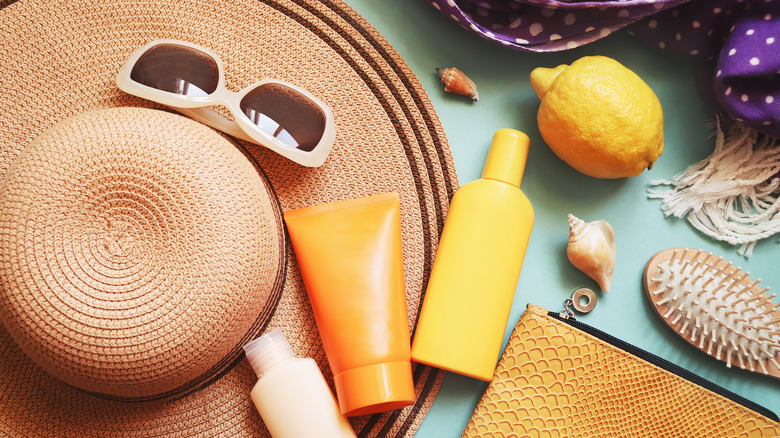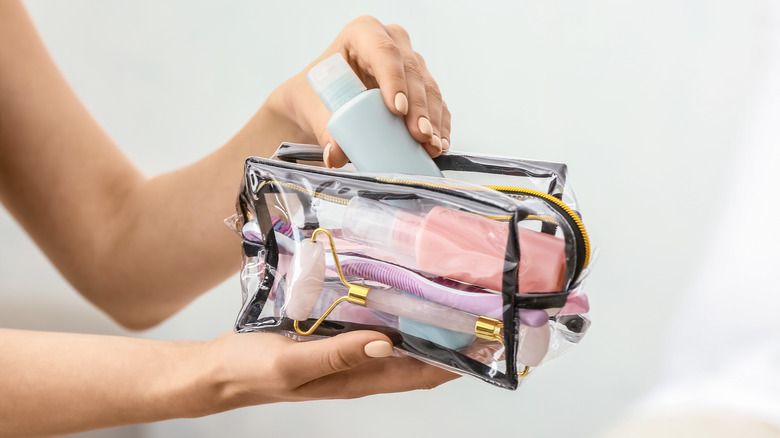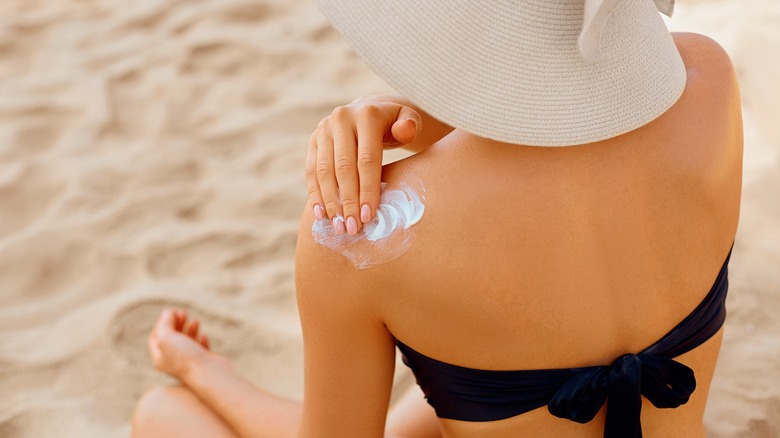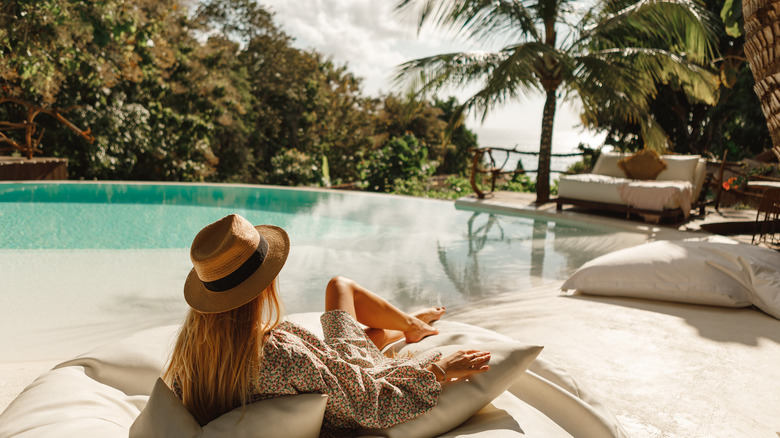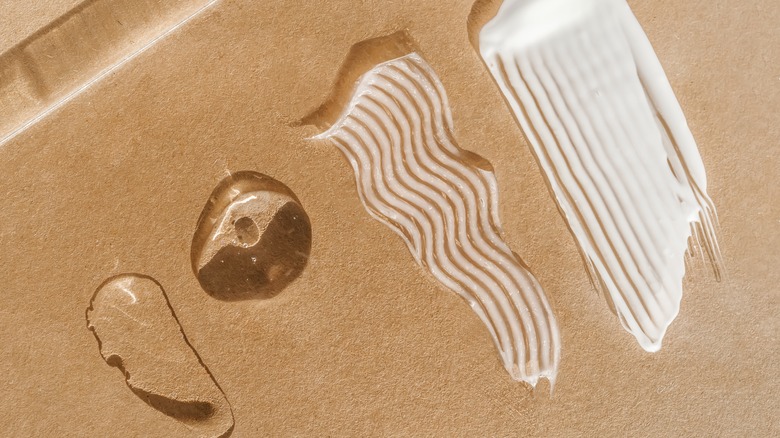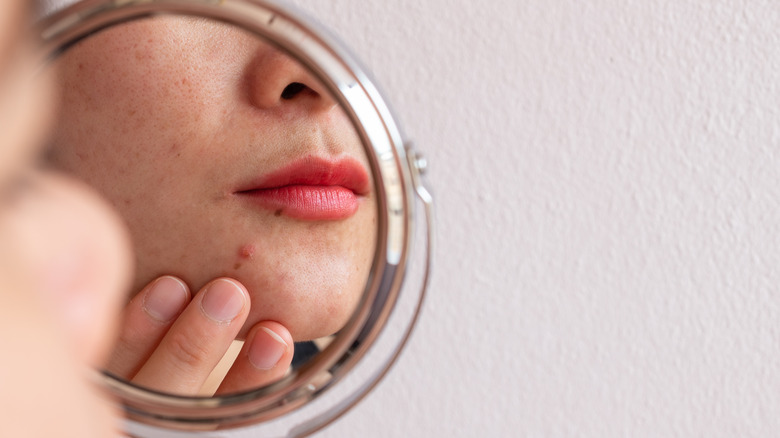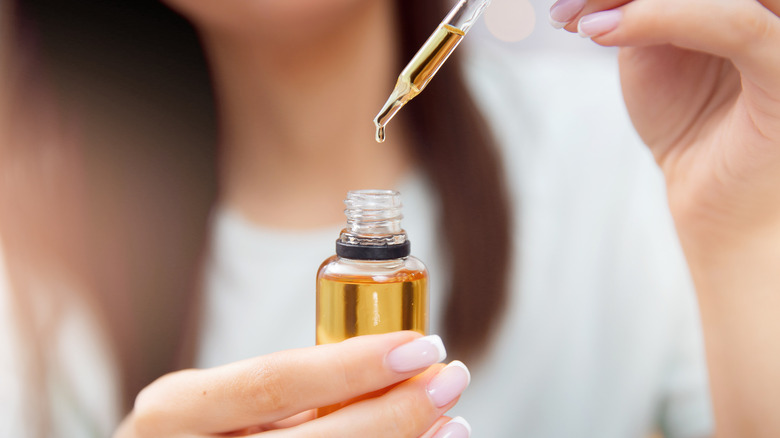Celebrity Esthetician Elina Fedotova Talks Summertime Skincare - Exclusive Interview
Let's talk summertime skincare. With all those products out there promising such big results, where's a person to start? How often do you need to apply sunscreen? How can you heal a horrible sunburn? Should the products you put on your face change along with the new season?
Health Digest spoke with the perfect person to help you achieve the complexion you've always admired in the summertime: celebrity licensed esthetician and cosmetic chemist Elina Fedotova.
From achieving an incredible tan to caring for an uncomfortable sunburn, Fedotova has learned it all over the course of her career. As the founder of Elina Organics, she's seen that putting only the most natural ingredients on your skin can improve its health over time and can even keep you glowing long after the summer sun sets. In an exclusive interview with Health Digest, she divulged all her secrets for the season all about showing off your skin.
Elina Fedotova shares the basics for the best summer skincare routine
Why is it so important to use organic ingredients on your skin?
Your skincare products should be like a fresh meal for your skin. More and more research shows your products can end up in your bloodstream, so I believe in skincare products formulated from food-grade ingredients that aren't harmful to our bodies.
When [the ingredients are] extracted from nature, our skin and body respond better to light concentrations of active ingredients, vitamins, antioxidants, and other active micronutrients. Our body recognizes it as familiar and [it] practically acts like food, not like a tablet or quick fix for your skin.
Also, ingredients derived from nature and botanical extracts consist of a symphony of supportive micronutrients that improve their performance. Using all-natural, pure, organic ingredients treats your face and body to a feast of nutrients that translates into bright, radiant, healthy, and younger skin!
How should your skincare routine change in the summertime?
There are several reasons we must adjust our skincare regiment when the seasons change. Our sebaceous oil glands are more active in the summertime because of the warm temperature. Using skincare products with hydrating and nourishing botanicals like aloe vera, rose water, vegetable glycerin, hyaluronic acid, and tremella mushroom are essential. The products should not have heavy emollience.
People tend to take their regular winter regimen to humid and warm places like Florida or continue using it in the summer. They will discover that their skin is too shiny and may even experience a few breakouts because of excessive oil production.
Creams and lotions should be more emollient in the winter and lighter in the summer to compensate for the effects of weather changes. In the summer, I also would not suggest using serums with alpha hydroxy acids (AHAs) during the day, because they make your skin more vulnerable to UV damage. Do not forget to wear your sunscreen no matter where in the world you live or what time of year it is.
How the city you're in should influence your skincare routine
Should the environment where you live affect the type of skincare products you use?
Definitely. If you live or travel to dry desert places like Arizona or West Texas in the middle of winter, I advise keeping your regular winter regimen the same, because your skin will still require extra hydration to compensate for the lack of moisture in the air.
I always suggest that my clients treat their skincare products similarly to how they choose their food. If you are in a dry climate, you are thirsty and drink more. In cold temperatures, you probably need more heavy and spicy food. On a tropical vacation, you feel great by eating light and fresh foods. Apply the same principles to your skincare routine and ask your skin what it needs today.
Do not forget to apply natural sunscreen in every geographical location in every season, but remember you especially will need sun protection when you are closer to the equator, on the water or snow, or in areas of high altitude. The snow and water reflect UV rays which can multiply sun damage. On the equator, you have the most intense UV radiation on the planet and less atmospheric protection when you are at a high altitude. Our atmosphere acts as a UV filter; UV damage is more intense in those areas when you have fewer layers.
If in a tropical, humid, and warm place like Florida, people with oily/acne-prone skin do not even have to use moisturizers, because many contain oils. I suggest only using treatment oil-controlling serums and zinc oxide-based sunscreen. Zinc oxide not only protects from solar radiation but also has an antibacterial and skin-calming effect, which is beneficial for irritated complexions.
Everything you need to know about sunscreen
How often should you be applying sunscreen during a day outdoors?
I believe in using mineral-concentrated sun protection, which offers physical skin protection by reflecting UV rays, preventing them from penetrating the skin. Chemical sunscreens are based on different principles and contain many synthetic ingredients [that] do not necessarily nourish the skin.
The application depends on the type of sunscreen, and each of us has our immune protection against UV. To understand how long it will take you, you must go in the sun and see how long it takes to get red. It could be just a few minutes for a very light complexion or a little longer for a complexion with more melanin. It could also depend on the season or geographical location. If it takes you 10 minutes without turning red, then a sunblock with 8 or 10 will extend your sun exposure 8 or 10 times, and then after that, you will need to reapply, which is 100 minutes.
Sometimes people apply sunscreen in the morning and then excessively sweat or swim, and then they are surprised that they get hyperpigmentation and burn even though they are wearing sunscreen. Sunscreen is not called sunblock, because it is only screening; it is not blocking. The best way to block the sun is to wear a hat and cover it with clothing.
Which SPF is best when it comes to sunscreen?
We don't have many choices when it comes to sunscreen ingredients that are healthy and effective. We have all heard about chemical sunscreen ingredients like oxybenzone, avobenzone, octisalate, octocrylene, homosalate, and octinoxate. Nowadays, these sunscreen ingredients are banned in Hawaii, because they are damaging to nature. Being an organic formulator, I never liked them and used them myself.
Zinc oxide continues to be the safest and most effective sun screening ingredient. It helps to protect our skin from UVA and UVB rays. In 2008, some companies introduced zinc oxide in a micronized form, hoping to develop completely translucent, more pleasant sunscreen products with micro or nanoparticles of zinc oxide. Unfortunately, it didn't work as expected, and traditional white zinc oxide remains the best solution.
The products you should and shouldn't wear while out in the sun
What kind of ingredients should we look for in sunscreen?
I have always used natural and unprocessed zinc oxide as a holistic and organic formulator. When looking for a safe sunscreen with zinc oxide, I suggest choosing one with a minimum of 23% zinc oxide to achieve broad-spectrum protection from UVA and UVB rays and prevent sun damage.
When selecting products for your morning skin care regimen, you must ensure that those products nourish, hydrate, and protect your skin during the day. Before going outside on warm summer days, we need to ensure we will enjoy the sun without any unpleasant health side effects.
Which skincare products or specific ingredients should be avoided while spending time out in the sun?
Any type of exfoliate, enzymes, and acids — fruit acids like lactic acids, glycolic acid, malic acid (apple), and others — are beneficial for skin hydration and fighting discoloration and wrinkles. Still, unfortunately, they make your skin photosensitive and should be avoided. In other words, they can contribute to more UV damage if you wear them on a sunny day. That includes practically all types of skin acids like salicylic, mandelic, and azelaic.
I wouldn't advise heavily exfoliating your skin with scrubs, because we don't want to thin out the protective layers of dead skin cells on our face and body before being in the sun. Eating foods containing hydrogenated oils before you go outside can also cause more photosensitivity. Eating colorful fruits and vegetables like tomatoes, grapes, and eggplants — which are concentrated with powerful antioxidants — strengthens your skin's natural defense to the sun's rays.
Here's exactly how to heal dry skin
What types of products are best at hydrating dry skin throughout the summer?
People often believe that they must add oils and butters if their skin feels dry and dehydrated. Oils and butters are made from natural fat and are only beneficial for your skin if you need emollience or a protective layer that holds moisture in.
Instead, when your skin is dehydrated, you need to use ingredients that attract more moisture into your skin. One of the most popular ingredients is hyaluronic acid, a protein that helps draw water into your skin. Another common ingredient is tremella mushroom, vegetable glycerin, and aloe vera. Lactic acid and other alpha hydroxy acids (AHAs) also help to hydrate your skin. I prefer hydrating masks made from natural peptides and some of the ingredients I listed above, because it helps to hydrate and nourish your skin without creating an extra layer of oils.
What types of products are best at hydrating specifically dry, cracked lips?
Your lips could feel dry because of lack of moisture, or because the weather is too dry or cold, or wind burn. Other times, your lips can crack because of a viral inflammatory process like cold sores or an allergic reaction to some foods or cosmetic products. It can also happen when your body is dehydrated or your immune system is suppressed.
When we want to condition the lips, we should use healing nutrients that help reduce inflammation, like aloe vera, honey, sea buckthorn extract, and cranberry extract. I also recommend using nourishing and protective ingredients like Vitamin E, shea butter, or cocoa butter. You can use a natural lip plumping serum or lip balm with natural coffee extract, which increases microcirculation and makes your lips more colorful and refreshing.
Your lips can also look very dry or cracked in the morning. A simple lip mask that includes an extract of honey would be very helpful. If you don't have a product like that, you can gently massage your lips with a slice of cranberry and apply a little raw honey on your lips for 5 minutes to refresh them! You can then use a specialty lip balm once the mask is removed.
For lip rejuvenation, I use spicules extracted from sponges like Lubomirskia. Lubomirskia micro-crystals penetrate the skin, creating micro-channels that stimulate active skin repair and protein regeneration while delivering skin-firming micronutrients into live skin cells.
What you should do about breakouts in the summertime
What's the best way to avoid breakouts caused by sweating in the summertime?
People with congested, oily complexions can feel dry because their skin is dehydrated, and to minimize this dry feeling, they tend to use heavy creams and lotions. Make sure to differentiate between hydrating ingredients and ingredients that are heavy in emollience. Hydrating ingredients include vegetable glycerin, hyaluronic acid, extracts of tremella mushroom, and gel from cacti and aloe vera. Emollience ingredients include plant oils, shea butter, and cocoa butter. I would also suggest that people avoid products containing silicone derivatives and other ingredients that end in a "cone" because they produce a thin film over the skin, which can contribute to the formation of blackheads by trapping oil under the silicone film.
I do not suggest using oils for acne-prone complexions, except tea tree oil. We see in the skincare practice that so many people have a dry crust of oil on the top of their skin and many breakouts underneath. They have entirely dehydrated complexions. It should be a light water-based emulsion or cream containing less than 20% oils. Those oils should be light, like almond oil.
Serums are an essential treatment product with a high concentration of corrective ingredients for particular complexions. Serums usually look like a liquid, because they must penetrate deep into your skin to achieve specific corrections. You cannot substitute a moisturizer with a serum. They both play a significant role. A serum for acne-prone complexion should be made with cooling, calming, and anti-inflammatory herbs like burdock root or calendula. It is also fabulous if they have a natural form of fulvic or salicylic acid. Serums need to be applied to irritated or inflamed areas before your moisturizer.
I also recommend using gentle scrubs that help purify the pores and masks with clay bases that contain minerals such as copper and sulfur. They help drain impurities and excessive oil out of the pores.
The secret to achieving an incredible tan and how to heal a sunburn
What is the safest way to get a natural tan in the summertime?
Rule number 1: No hydrogenated oils. Stop eating food with hydrogenated oils and any processed foods. It suppresses your natural immunity to sun damage.
Rule number 2: Eat tons of antioxidants. It is scientifically proven that people who eat a very high level of antioxidant-rich diets, fruits and vegetables, and anthocyanosides can stay in the sun without any protection much longer because their bodies can protect them naturally from UV damage.
Rule number 3: Use a sun block, preferably one that is zinc oxide-based. Wear protective hats and always be careful in the sun.
With these three rules, you will achieve beautiful results.
What are the best ingredients to use on a sunburn to help it heal quickly?
Sea buckthorn has the most natural balanced healing cocktail of vitamins, and micronutrients like beta keratin and omega-7 blended with others. It has an incredible healing effect on the skin. It is often taken internally to heal the digestive system and is used topically to soothe and restore the skin after sun damage, trauma, and burns. It also has an antiseptic effect and helps balance the skin microbiome by reducing pathogens.
It is possible to reverse some of your skin's sun damage
Are dark spots and other skin damage from the sun reversible?
Skin discolorations could be just on the surface from sun damage or affect very deep layers of the skin. Surface spots are very easy to remove with gentle exfoliation using a natural enzyme peel or microdermabrasion. If we are talking about dermal sun damage like melasma — which is very deep — it could take a long time, and that time could vary and is also related to the hormonal activity of each client. For example, pregnant people or women who use medications that help to elevate their estrogen, like birth control or hormonal therapy, can exhibit more photosensitivity. Other medication types could also affect that, so we need to be aware that some of us could be more prone to sun damage than others.
When you approach any hyperpigmentation — surface or deep inside — we must work in two directions simultaneously. To reduce discoloration, we may use topicals containing ingredients like mandelic, kojic, or azelaic acid, some of the most potent acids to lighten up hyperpigmentation. I also recommend using highly concentrated hydrogen peroxide.
Hyperpigmentation [and] sun damage results from oxidative stress when the skin is damaged on a cellular level, and powerful antioxidants like resveratrol help heal and restore the skin cells when applied topically and taken internally. Then we need to treat that area with a powerful blend of antioxidants which also, by themselves, can reduce discoloration because they are going to restore the skin on a cellular level.
I suggest addressing hyperpigmentation with topicals and internal products such as diet adjustments. Purple-colored berries and vegetables like blueberries and eggplants are essential because they contain anthocyanosides, one of the most potent antioxidants.
Some organic spas not interested in using acid peels can even offer face massages with actual slices of eggplants or sliced mushrooms. Mushrooms naturally contain kojic acid, which helps to reduce discoloration to lighten the skin. All mushrooms you can find in the store also have a very high concentration of antioxidants which also lighten spots and help restore skin cells from oxidative stress.
The approach should be two-fold: Lighten the skin topically with something natural, and use antioxidants to heal the deep skin cells in that area. If you do not use antioxidants and only topically bleach, the hyperpigmentation will return because the skin regenerates from the inside out. Eventually, when the bleached surface flakes off, new discolorations will come to the surface unless you restore your live skin cells from oxidative stress with antioxidants.
What types of changes to the skin should people be on the lookout for in the summer that would warrant a visit to a medical professional?
If you notice a mole or dark spot is getting darker or changing shape, it's best to get it looked at by a professional. It would be best if you also look for areas on your skin that could look red and scaly and do not seem to be healing for a while, no matter what you do to try and heal it. Overall, it is good to check the moles on your body every year professionally.
Learn more about Elina Organics Holistic Clinical Skincare at www.elinaorganics.com, and follow along on Instagram @elinaorganics.
This interview has been edited for clarity.

